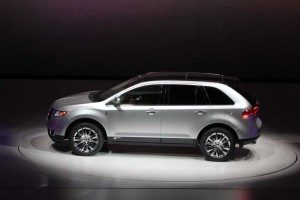More than a third of the dealers representing Ford Motor Co.’s only remaining luxury brand will be eliminated under a dramatic go-it-alone restructuring plan for the Lincoln division.
Bringing Lincoln’s retail network more in line with its import competition is just the first step in a broad brand transformation that will also yield seven all-new or significantly updated models for the marque in the next four years. (Click Here for that story.)
“We are fully committed to transforming Lincoln into a world-class luxury brand,” Mark Fields, Ford’s President of the Americas, told about 900 of the division’s dealers and their representatives during a meeting in Dearborn, Michigan.
But the presentation also outlined some serious challenges for a Lincoln revival.
Until about a decade ago, Lincoln was a strong contender in the U.S. market, locked in an ongoing battle for sales dominance with its cross-town rival Cadillac. But the new millennium saw a shift away from domestic to import luxury brands, with makers Lexus, BMW and Mercedes-Benz surging to the top of the sales charts.
Lincoln is now a second-tier competitor, but it has far more dealers than those stronger imports, company officials pointed out – especially in urban markets where it has become common for Lincoln dealers to battle it out among themselves rather than targeting the competition.
So, the maker outlined a goal of eliminating 35% of those 500 metro stores, a total cut of about 175 retailers, some of which have been with the Lincoln brand since it was first launched in the years before World War II.
According to Fields, the step is painful but a necessary way “to be competitive.”
In the coming months, all Lincoln dealers will meet with corporate representatives to determine whether they can and should remain with the brand. Some will get the green light, others may be encouraged to handle only the Ford brand. Others will be advised that they are no longer needed.
Ford follows General Motors and Chrysler in trying to realign its dealer network. But where those makers used the cover of bankruptcy to drop retailers cold – and eventually chose to back down by rehiring many of the abandoned outlets – Ford is only now rethinking its distribution structure and will likely negotiate a buy-out for unneeded dealers.
That process could be a costly one, however, since paying a dealer to go away typically runs into the millions of dollars.
Those dealers who do remain with the Lincoln brand will be expected to upgrade their stores, Ford stressed during the meeting. The maker said only about one in four stores is currently up to the planned standards.
Those dealers who remain with Lincoln, said Fields, will “need to invest differently than in the past.”
The proposed cuts in metro-based dealerships will still leave Lincoln with more retailers than the import competition – which average about 500 each. That is a challenge in several ways. With fewer sales per outlet retailers are more reluctant to make major investments.
The grand realignment just getting underway at Lincoln was triggered by several factors. First, Ford has sold off its once-numerous collection of import luxury brands, including Jaguar, Land Rover and Aston Martin. It also decided, over the summer, to eliminate the long-troubled Mercury brand, which had been partnered with Lincoln for decades.
But simply cutting retailers and adding more product is no guarantee of success, cautioned a senior executive with a competing foreign-based brand. Asking not to be identified by name or company, he said, “Lincoln doesn’t have the resources, nor the economies of scale to compete since it is only a domestic brand. You really have to compete globally to get your volumes up.”
Indeed, the three leading German luxury makers are each pushing up to and past the 1 million vehicle a year level, many times more than Lincoln. That allows them to come up with a broader model mix while still holding costs down by sharing components.
Lincoln has several times considered reaching beyond North American shores, but has repeatedly pulled back.
“Lincoln is still five to six years away from launching products that have (global) credibility,” Ford corporate design director J Mays cautioned during a Paris interview. “If, when we launch products that have that credibility maybe then we can have that conversation.”

